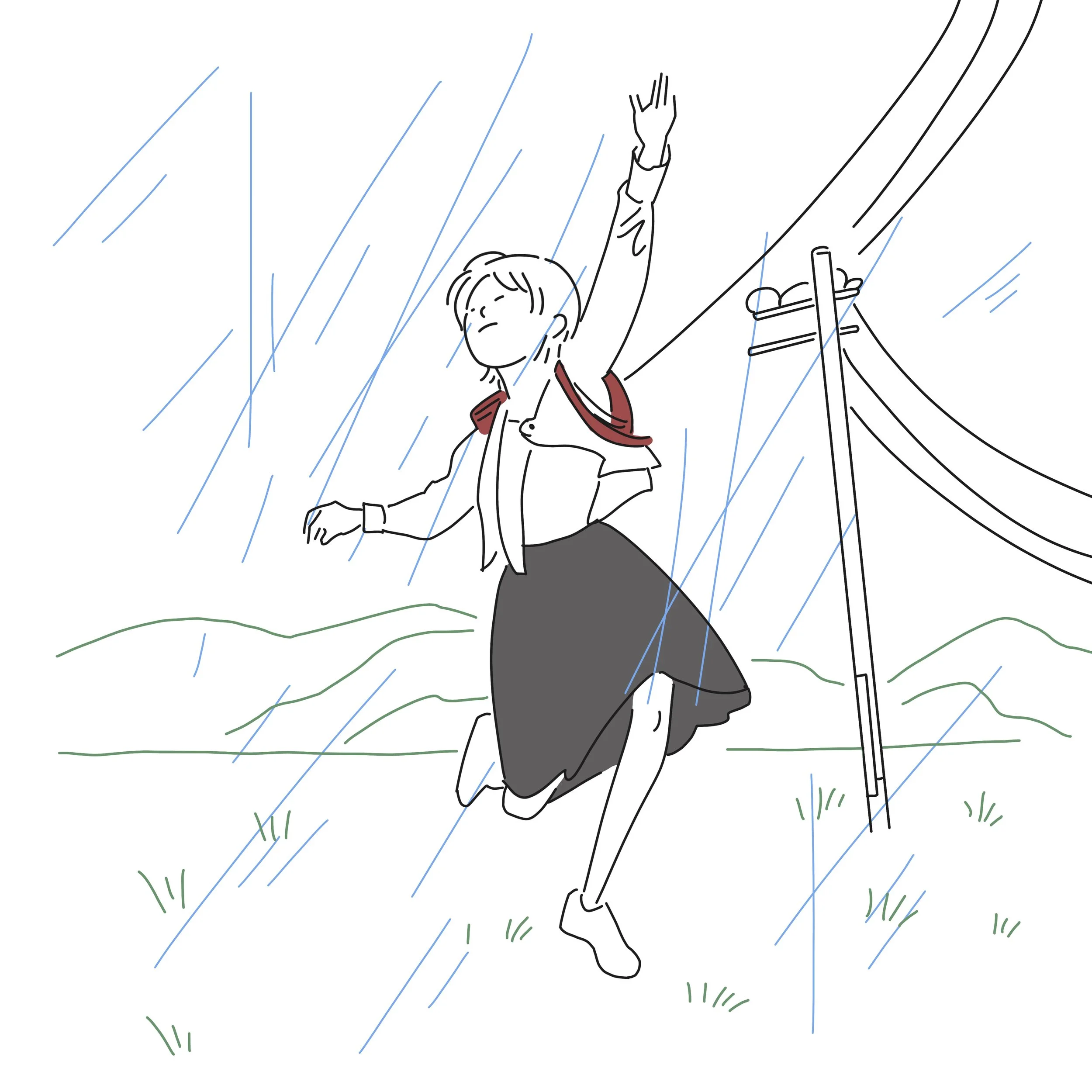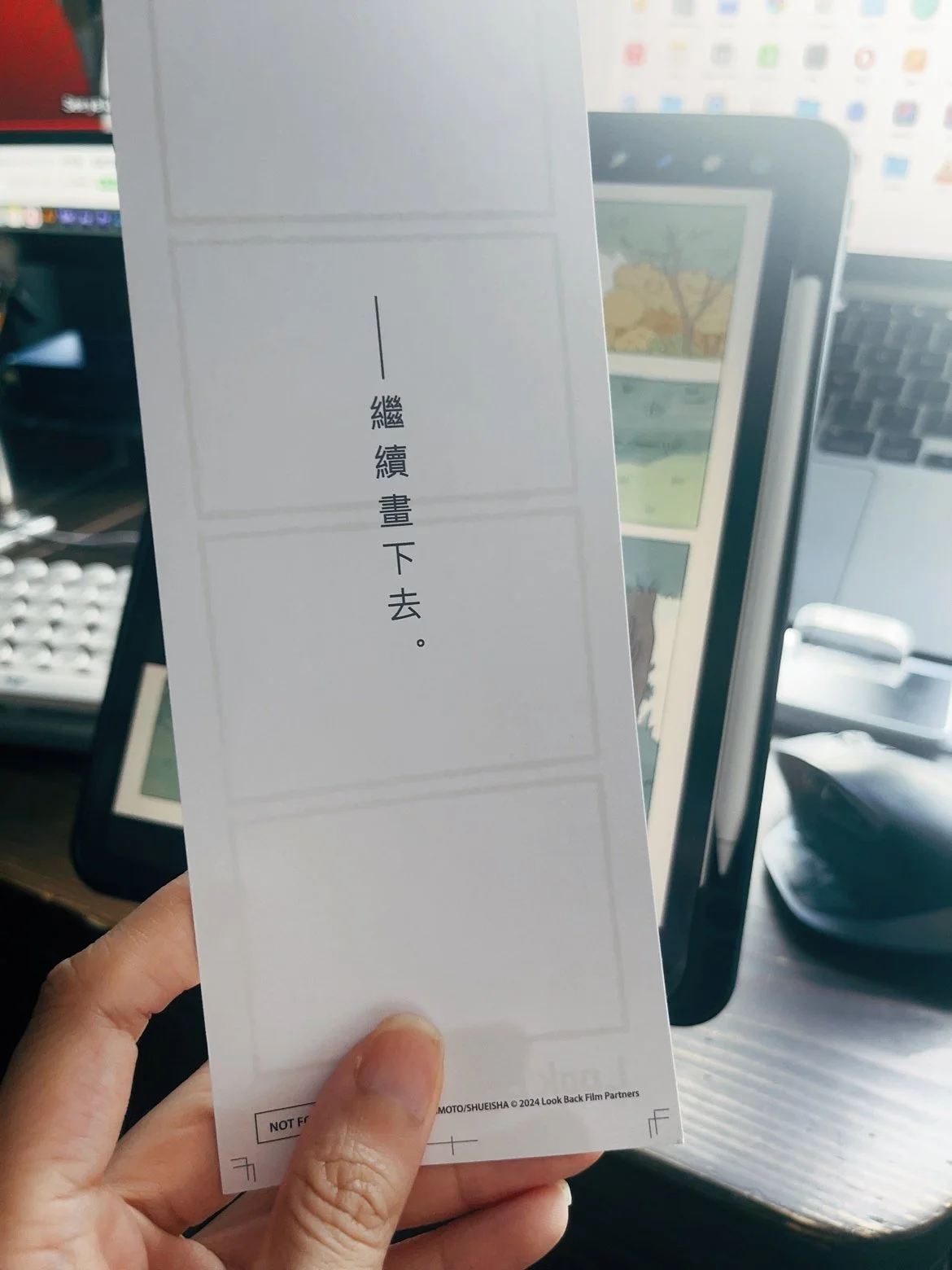Look Back (2024)
English Version At Blow
畫、一直畫下去
藤本樹的這篇短篇漫畫,其實我一直都十分喜歡,沒想到竟然成了一套電影。
這次的電影有我很喜歡的音樂創作人Haruka Nakamura, 去創造關於這部電影的主題曲以及各種音樂,在大屏幕上看到這一個短篇漫畫配合音樂並動起來的樣子令人有種莫名的感動,情節不是催淚向的,我郤不時看到觀眾們偷偷擦眼淚。
它的故事其實也沒有很複雜,我在這裏便不多劇透了,有興趣的話歡迎先去看電影。
我反而想談一下作為一位很喜歡畫畫的人,我相信很多人會看到自己的影子,在旁邊的人不理解以及其他人不支持的狀況下要繼續自己一直喜愛的東西是非常難的。我相信在戲院觀眾席裡不時流淚的人們,也許是因為了看到自己的影子而擦淚。
最近在IG還有不同的地方都看到很多人畫藤野在書枱前面的一幕,我自然也是很喜歡那個橋段,他令我想起小時候一個人在畫桌前拼命研究不同畫集的時光。這段時間,也許有些人會覺得很孤獨,但同時,能夠以自己雙手或出自己腦中的畫面是多麼大的成就感啊。這些時光是必需,而又很個人的。
我最喜歡的一段:是藤野在京本稱她為老師,她好像沒有很在意,但在雨中卻不自覺開心得翩翩起舞。
人就是這樣,不想要讓其他人覺得自己沾沾自喜,但在一些別人可能不自覺的鼓勵下,自己卻高興得無法不跳舞起來。那一幕沒有對白,只有在雨中跳舞的藤野,但隨着她胡亂的腳步,觀眾的心都跟着同樣地翩翩起舞。
值得一提是在電影中我看到不少跟漫畫,繪本相關的彩蛋,其中一幕是京本在書店裡打開了一本插畫書,我卻驚覺這張畫,我曾經在哪裏看過啊。在最後電影出現幕後人員名單的時候,我發現美術監督男鹿和雄(曾參與多部川尻善昭執導或吉卜力工作室動畫作品的背景美術製作)也有份參與製作,而那張畫曾是我張貼在房間裡長達幾年的海報。
這部動畫的線條就像漫畫一般,不是完全的工整、時不時留有手繪的㾗跡。故事情節很簡單,但人物的互動和關係卻是有趣,藤野跟京本有自己的問題、缺點,她們有自私的一面、有不自信的一面,但她們的感情郤是令人羡慕的,彷彿是一個硬幣的兩面。
這部電影是關於夢想,是關於懊悔,它是快樂的故事同時是令人遺憾的。
希望每一位喜歡畫畫或者從事畫畫的人,像她們一樣在經歷不同的挫折以後,不要輕視曾經的自己,不要抹殺過去、努力,拿起畫筆,還是一樣繼續畫下去。
But don't look back in anger, I heard you say.
沒有拿到戲院送的特典,只有在carousell再買
看戲時拿的書簽
Draw, Keep Drawing
I've always loved this short comic by Tatsuki Fujimoto, and I never expected it to become a film.
This time, the movie features music by Haruka Nakamura, a composer I really admire, who created the theme song and various pieces for the film. Seeing this short comic come to life with music on the big screen was incredibly moving. The plot isn’t overly sentimental, yet I noticed audience members secretly wiping away tears.
The story itself isn’t very complicated, so I won’t spoil it here. If you're interested, I encourage you to watch the movie.
I want to discuss, as someone who loves drawing, how many people might see their own reflection in this. Continuing to pursue what you love amidst misunderstanding and lack of support from others is incredibly difficult. Perhaps those in the theater, shedding tears, were doing so because they recognized themselves in the story.
Recently, I've seen many people on Instagram and other platforms drawing the scene of Fujino at her desk, which I also love. It reminds me of my childhood, spending hours at my drawing table studying various art books. During that time, some might feel lonely, but the sense of achievement from creating something with your own hands or imagination is immense. Those moments are necessary and deeply personal.
One of my favorite parts is when Kyomoto calls Fujino "teacher." She seems indifferent, yet dances joyfully in the rain without realizing it.
That’s how people are; they don’t want to seem self-satisfied, but sometimes, through the encouragement of others, they can’t help but dance with joy. That scene had no dialogue, just Fujino dancing in the rain, and with her erratic steps, the audience's hearts danced along.
I spotted many Easter eggs related to comics and picture books in the film. One scene has Kyomoto opening an illustrated book in a bookstore, and I suddenly realized I’d seen that artwork before. At the end, when the credits rolled, I discovered that art supervisor Masaki Oga, who has worked on many projects with Yoshinori Kanemori and Studio Ghibli, was involved, and that artwork had been a poster in my room for years.
The animation's lines resemble those of a comic, not perfectly neat, but occasionally retaining hand-drawn imperfections. The plot is simple, yet the interactions and relationships between the characters are fascinating. Fujino and Kyomoto each have their own issues and flaws; they can be selfish and insecure, but their bond is enviable, like two sides of a coin.
This film is about dreams and regrets; it’s a joyful story yet also bittersweet.
I hope everyone who loves drawing or is involved in art, like them, after facing various setbacks, doesn’t underestimate their past selves, doesn’t erase their history, and continues to pick up the brush and draw.
But don't look back in anger, I heard you say.
The Story Board of the movie is interested
And I got this bookmark in the theatre as an souvenir





